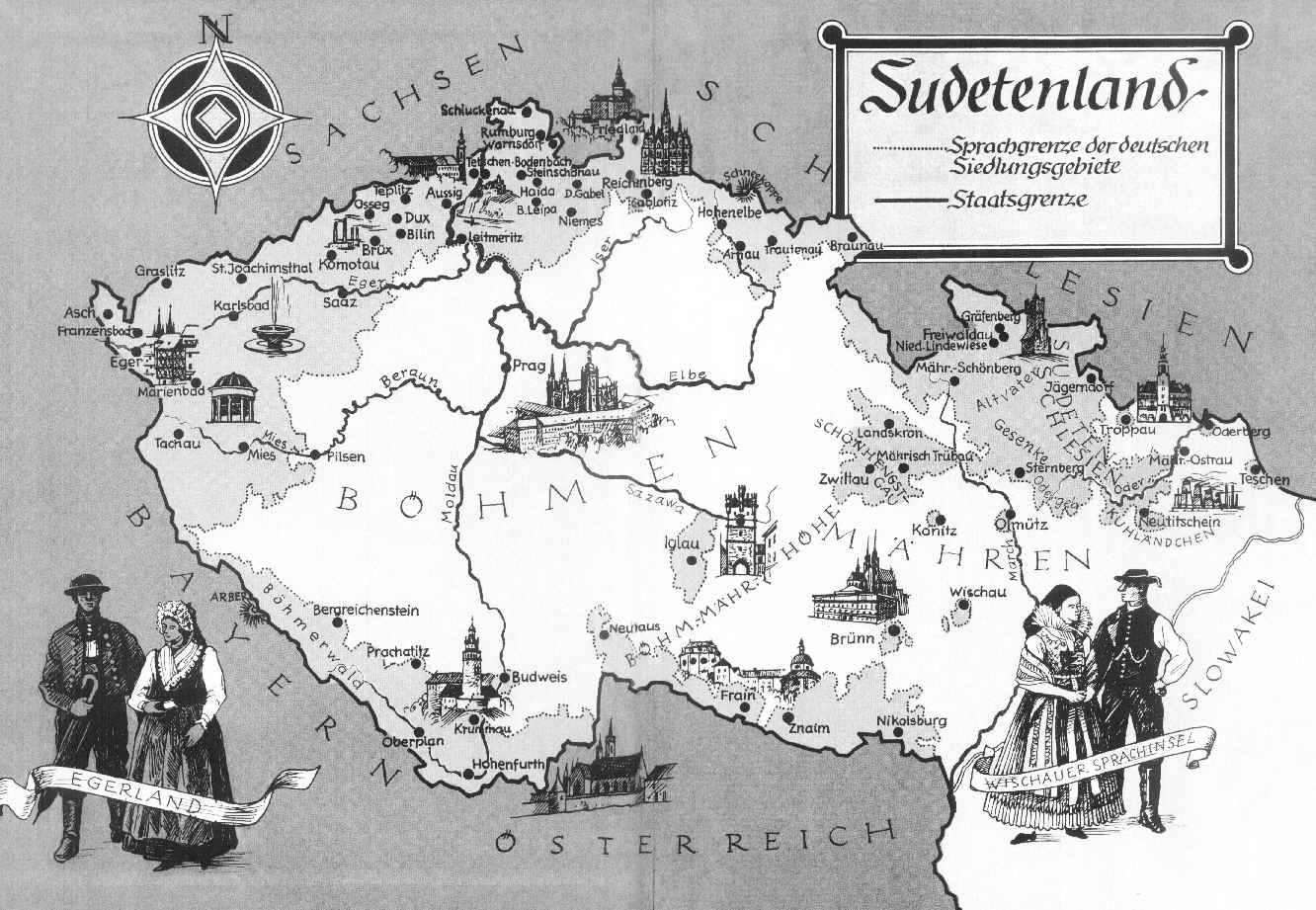
Interview with Professor Francesco Leoncini – an internationally renowned historian and professor of Slavic and Central European history at the University of Venice
The term “Sudeten” came into use in 1918, the year of the foundation of the Czechoslovakian state, the German language minority in Bohemia that had been present on that territory since the Middle Ages and before that date, known as “Bohemian-Germans” and “Silesian-Germans”.
“The term derives from the homonymous mountain range located in northern Bohemia and refers to a group within a new state that was to have a unified identity,” explains Professor Francesco Leoncini – the internationally renowned historian and professor of Slavic and Central European history at the University of Venice – a real expert on the subject, to which he has dedicated a book entitled “The Sudeten issue 1918-1938”, published by Liviana, Padua 1976. We met him in Prague last
April at a conference on the Italian Risorgimento, organized by the Italian Institute of Culture. We took the opportunity to get to know his views on this subject, opinions that are often in contrast with those of both Czech and German historians. According to prof. Leoncini, at the end of the First World War, the Sudeten political leaders rejected the Czechoslovakian state, claiming they belonged to German Austria, Deutschösterreich. “The Czechs invited them to take part in a Constituent Assembly in so far as the idea of Edvard Beneš, the then foreign minister of Czechoslovakia, was to create a system similar to that of Switzerland, based on the Swiss cantonal system, due to the different ethnic groups on the territory. The Berlin representative in Prague was also of the same idea and invited the Sudeten politicians to take part in the Constituent, declaring that such action would have a strong impact on the future destiny of the new state. But the Sudeten were all strongly against it”, Leoncini points out.
A number of historians claim that Beneš, at the Paris Peace Conference of 1919, had lied about the actual number of Sudeten present in the new state, to support territory concessions to Czechoslovakia, and pursued a policy of forced assimilation against the ethnic minorities present on the territory. The latter is, however, a thesis that Leoncini refutes by putting forward the argument that: “Among the successor states of the Habsburg Monarchy, Czechoslovakia was the one that most of all respected and guarantees the development of the minorities. During the two wars, in fact, it was the only country, East of Switzerland, that held a democratic structure with full political representation. Let us not forget that the Communist Party was legal and that the minority groups had ministers within the government. “The Italian historian is also very critical towards those scholars who see in the Sudeten issue a failure to apply the famous Fourteen Points, exposed in 1918 by U.S. President Woodrow Wilson at United States Senate, for a new post-war world order with the popular principle of people’s right to self-determination. “When we took a decision on the on the Czechoslovakian border – Leoncini points out – Wilson intervened first hand, who was asked if he approved them, and since the Sudetens had never been part of Germany, it would not make sense to exclude them from the Czechoslovakian border. Anyway, the right to self-determination had to be contextualized and could not be defined as absolute, as for example with the right to liberty or property. If it had been applied mechanically, the first to benefit from it would have been the Germans, who would have then expanded. Therefore, such a solution in favour of Germany was considered unacceptable. We should also add that Wilson, at the beginning, did not speak of “self-determination” but of an “autonomous development of the people of Austria-Hungary.” Wilson envisaged this situation placed in a new world order of which the League of Nation were to be the guarantors”.
Leoncini is equally critical of the argument according to which, in the aftermath of World War I there was a certain determination by the victorious States to punish Germany. “This took place towards the end of the Second World War. Instead, after the Great War, Germany was subject to very limited territorial losses and even war reparation was not decided in Paris, but later on. So, even that is a myth”.
We also have to add that the Sudetens were themselves divided in their political participation within the Czechoslovakian government, even if in 1926 they were also able to gain a number of ministers. The Sudeten parties were legal within the new state and one of them, the Sudetendeutsche Partei, became the first party in Czechoslovakia for number of votes and almost gained the relative majority. At the beginning with a somewhat conservative political policy and around 1935 it moved towards a form of cantonalization of Czechoslovakia. The turning point came between 1936 and 1937 when close contacts took place between the Party and the Reich until 1938, when this became the instrument that Hitler used to destroy Czechoslovakia.
“After the war – Leoncini explains – there was the expulsion of the Sudeten (that involved about 3 million people en. An operation that was also driven by a desire for vengeance against Germany on the part of the victorious States that, as we have seen, had not occurred at the end of the First World War. ”
The Italian historian does not fail to remind us that “After the expulsions, relations between Germany and Czechoslovakia were clearly hostile and full of indifference, and were to change only with on advent of Ostpolitik, when Brandt went to Warsaw to apologize for what the Germans had done. And in 1973, a new kind of relationship developed between Czechoslovakia and the German Federal Republic”. Still today in Germany, a strong role is played by the Landsmannschaft Sudetendeutsche Association that is located in Munich, with an office also in Prague. “After the expulsion – Leoncini maintains – many Sudetens moved to Bavaria, and Munich changed from a farming town to an industrial city, where the Sudetens became a strong lobby that influenced the Bonn government. As for current relations between the two countries after the fall of the Berlin Wall and the reunification of Germany, we have to say that the Czechs feel somewhat surrounded by the German-speaking world, so it’s purely a psychological problem. Bohemia is like a wedge between Austria and Germany; there is still a sense of fear, a sort of subordination complex towards this looming neighbouring country, whose economic power in the Czech Republic today is quite strong”.
By Mauro Ruggiero from Progetto Repubblica Ceca, September -October 2011
Prof. Francesco LeonciniI tedeschi dei Sudeti e la loro “questione”
Intervista al professor Francesco Leoncini – storico di fama internazionale e docente di Storia dei Paesi Slavi e Storia dell’Europa Centrale presso l’Università di Venezia
Con il termine „sudeti“ viene indicata a partire dal 1918, anno della costituzione dello stato cecoslovacco, la minoranza di lingua tedesca in Boemia presente sul territorio fin dal Medioevo e prima di questa data conosciuta come „tedeschi-boemi“ e „tedesco-slesiani“.
“Il termine deriva dall‘omonima catena montuosa situata a Nord della Boemia e indica un gruppo inserito in un nuovo stato che doveva avere una sua identità unitaria“ ci spiega il prof. Francesco Leoncini – storico di fama internazionale e docente di Storia dei Paesi Slavi e Storia dell’Europa Centrale presso l’Università di Venezia – un vero esperto di questo argomento al quale ha dedicato il volume „La questione dei Sudeti 1918-1938“ edito da Liviana Editrice, Padova 1976. Lo abbiamo incontrato lo scorso aprile a Praga, in occasione di un convegno sul Risorgimento italiano organizzato dall’Istituto Italiano di Cultura. Abbiamo colto l’occasione per sentire le sue opinioni su questo tema, che sono spesso in controtendenza rispetto a quelle della storiografia, sia di parte ceca che tedesca. Secondo il prof. Leoncini, alla fine del primo conflitto mondiale, gli esponenti politici sudeti rifiutarono lo stato cecoslovacco sostenendo di appartenere all’Austria tedesca, Deutschösterreich. “I cechi li invitarono a prendere parte alla costituente in quanto l’idea di Edvard Beneš, l’allora ministro degli esteri della Cecoslovacchia, era di fare del nuovo stato un sistema simile alla Svizzera, che funzionasse in modo cantonale viste le diverse etnie presenti sul territorio. Della stessa idea era anche il rappresentante di Berlino a Praga che invitò gli esponenti politici sudeti a partecipare alla costituente dichiarando che una cosa del genere avrebbe fatto aver loro peso nei destini futuri del nuovo stato. Ma i sudeti rifiutarono in modo compatto” sottolinea Leoncini.
Una serie di storici affermano che Beneš, in occasione della Conferenza di Pace di Parigi del 1919, mentì sul numero effettivo dei sudeti presenti nel nuovo stato, per favorire le concessioni di territorio alla Cecoslovacchia e portò avanti una politica di assimilazione forzata nei confronti delle minoranze etniche presenti sul territorio. Quest’ultima è però una tesi che Leoncini confuta con un argomento su tutti: “Fra gli stati successori della monarchia asburgica, la Cecoslovacchia fu quella che più di tutti rispettò e garantì lo sviluppo delle minoranze. Durante le due guerre, infatti, fu l’unico paese a Est della Svizzera a mantenere una struttura democratica con una rappresentanza totale delle forze politiche. Ricordiamo che il partito Comunista era legale e che le minoranze avevano ministri all’interno del governo”. Lo storico italiano si mostra molto critico anche verso quegli studiosi che vedono nella questione sudeta una mancata applicazione dei famosi Quattordici Punti, esposti nel 1918 dal presidente americano Woodrow Wilson al Senato degli Stati Uniti d’America, relativi al nuovo ordine mondiale post-bellico e al famoso principio di autodetrminazione dei popoli. “Quando si decise sulle frontiere cecoslovacche – sostiene Leoncini- intervenne direttamente Wilson al quale fu chiesto se le approvava, e visto che i Sudeti non avevano mai fatto parte della Germania, non avrebbe avuto senso escluderli dalle frontiere cecoslovacche. Il diritto all’autodeterminazione doveva comunque essere contestualizzato e non si poteva definirlo assoluto come ad esempio il diritto alla libertà o alla proprietà. Se si fosse applicato in maniera meccanica, i primi ad averne tratto vantaggio sarebbero stati i Tedeschi che si sarebbero ingranditi, quindi era impensabile un’applicazione del genere che avrebbe in questo modo favorito la Germania. C’è anche da dire che Wilson all’inizio non parlò di „autodeterminazione“ ma di uno „sviluppo autonomo dei popoli dell’Austria-Ungheria“. Wilson vedeva questa situazione collocata in un nuovo ordine mondiale di cui la Società delle Nazione sarebbe stata la garante”.
Leoncini è altrettanto critico nei confronti della tesi secondo la quale all’indomani del primo conflitto mondiale esistesse la volontà, da parte degli Stati vincitori, di punire la Germania. “Questo accadde piuttosto alla fine della Seconda Guerra Mondiale. Dopo la Grande Guerra, la Germania ebbe invece perdite territoriali molto limitate e le stesse riparazioni di guerra non vennero decise a Parigi, ma successivamente. Quindi anche questo è un mito”.
Bisogna anche dire che i Sudeti erano essi stessi divisi sulla partecipazione politica al governo cecoslovacco anche se nel 1926 riuscirono ad ottenere addirittura un paio di ministri. I partiti sudeti erano legali all’interno del nuovo stato e uno di essi, il Sudetendeutsche Partei, diventò il primo partito in Cecoslovacchia per numero di voti e per poco non prese la magioranza relativa. All’inizio con una politica di stampo conservatore, verso il 1935 si orientò verso una forma di cantonalizzazione della Cecoslovacchia. La svolta avvenne tra il 1936 e il 1937 quando iniziarono i contatti stretti tra il Partito e il Reich, finchè nel 1938, questo divenne lo strumento di cui si servì Hitler per annientare la Cecoslovacchia.
“Dopo la guerra – commenta Leoncini – ci fu l’espulsione dei sudeti (che coinvolse 3 milioni circa di persone ndr.). Una operazione spinta anche da una desiderio di vendetta degli Stati vincitori contro la Germania, cosa che, come abbiamo visto, non era accaduta alla fine della Prima Guerra Mondiale”.
Lo storico italiano non manca di ricordare che “Dopo l’espulsione, i rapporti tra Germania e Cecoslovacchia furono di netta ostilità e indifferenza e si sono poi diversificati solo con l’avvento della Ostpolitik, quando Brandt andò a chiedere scusa a Varsavia per quello che i tedeschi avevano fatto e nel ‘73 si sviluppò un nuovo rapporto tra Cecoslovacchia e Repubblica Federale Tedesca”. In Germania ancora oggi gioca un ruolo forte l‘associazione Sudetendeutsche Landsmannschaft che risiede a Monaco di Baviera e che è presente con una sede anche a Praga. “Dopo l’espulsione, – continua Leoncini- molti sudeti si trasferirono in Baviera e Monaco si trasformò da città agricola quale era, in una città industriale dove i Sudeti costituirono una lobby forte che condizionò il governo di Bonn. Per quanto riguarda i rapporti attuali tra i due paesi, dopo la caduta del muro di Berlino e la riunificazione della Germania, bisogna dire che i cechi si sentono in qualche modo circondati dal mondo tedesco e quindi c’è un porblema prettamente psicologico. La Boemia è come un cuneo tra Austria e Germania, e c’è ancora un senso di timore, un complesso di subalternità nei confronti di questo vicino che incombe, il cui potere economico oggi è forte in Repubblica Ceca”.
Di Mauro Ruggiero da: Progetto Repubblica Ceca, settembre -ottobre 2011





